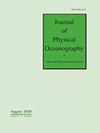Oceanic Frontal Turbulence
IF 2.8
2区 地球科学
Q1 OCEANOGRAPHY
引用次数: 0
Abstract
Upper-ocean turbulence results from a complex set of interactions between submesoscale turbulence and local boundary layer processes. The interaction between larger-scale currents and turbulent fluctuations is two-way: large-scale shearing motions generate turbulence, and the resulting coherent turbulent fluxes of momentum and buoyancy feed back onto the larger flow. Here we examine the evolution and role of turbulence in the intensification, instability, arrest, and decay (i.e., the life cycle) of a dense filament undergoing frontogenesis in the upper-ocean boundary layer, i.e., cold filament frontogenesis (CFF). This phenomenon is examined in large-eddy simulations (LES) with resolved turbulent motions in large horizontal domains using 109 grid points. The boundary layer turbulence is generated by surface buoyancy loss (cooling flux) and is allowed to freely interact with an initially imposed cold filament, and the evolution is followed through the frontal life cycle. Two control parameters are explored: the initial frontal strength M2 = ∂xb and the surface flux . The former is more consequent: initially weaker fronts sharpen more slowly and become arrested at a later time with a larger width. This reflects a competition between the frontogenetic rate induced by the secondary circulation associated with vertical momentum mixing by the turbulence and the instability rate for the along-filament shear flow. The frontal turbulence is energized by the shear production of the latter, is nonlocally transported away from the primary production zone at the filament centerline, and cascades to dissipation in a broad region surrounding the filament. The turbulent momentum fluxes arresting the frontogenesis are supported across a wide range of horizontal scales.海洋正面湍流
上层海洋湍流是由亚海洋尺度湍流和局部边界层过程之间复杂的相互作用产生的。大尺度海流与湍流波动之间的相互作用是双向的:大尺度剪切运动产生湍流,由此产生的动量和浮力的相干湍流通量反馈到更大的海流中。在此,我们研究了湍流在上层大洋边界层锋面发生过程(即冷丝锋面发生(CFF))中的强化、不稳定、停滞和衰减(即生命周期)中的演变和作用。这种现象是在使用 109 个网格点的大水平域中解析湍流运动的大涡流模拟(LES)中研究的。边界层湍流由表面浮力损失(冷却通量)产生,允许其与最初施加的冷丝自由相互作用,并通过锋面生命周期跟踪其演变。探讨了两个控制参数:初始锋面强度 M2 = ∂xb 和表面通量。前者的影响更大:最初较弱的锋面锐化得更慢,并在较晚的时间以更大的宽度停滞。这反映了与湍流垂直动量混合相关的次级环流引起的锋面生成率与沿丝切变流不稳定率之间的竞争。锋面湍流由后者产生的剪切力激发,以非局域的方式从丝中心线的主要产生区流走,并在丝周围的广阔区域逐级消散。阻止锋面生成的湍流动量通量在很大的水平尺度范围内得到支持。
本文章由计算机程序翻译,如有差异,请以英文原文为准。
求助全文
约1分钟内获得全文
求助全文
来源期刊
CiteScore
2.40
自引率
20.00%
发文量
200
审稿时长
4.5 months
期刊介绍:
The Journal of Physical Oceanography (JPO) (ISSN: 0022-3670; eISSN: 1520-0485) publishes research related to the physics of the ocean and to processes operating at its boundaries. Observational, theoretical, and modeling studies are all welcome, especially those that focus on elucidating specific physical processes. Papers that investigate interactions with other components of the Earth system (e.g., ocean–atmosphere, physical–biological, and physical–chemical interactions) as well as studies of other fluid systems (e.g., lakes and laboratory tanks) are also invited, as long as their focus is on understanding the ocean or its role in the Earth system.

 求助内容:
求助内容: 应助结果提醒方式:
应助结果提醒方式:


